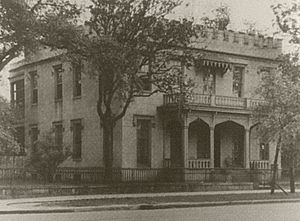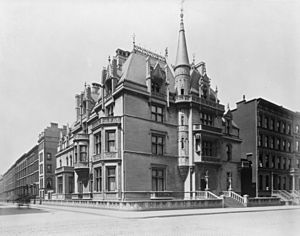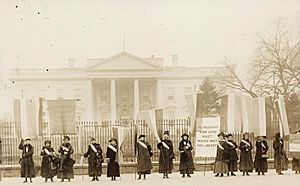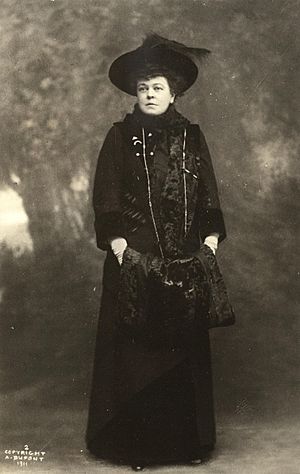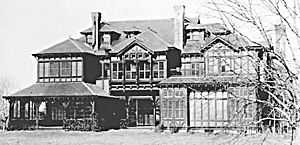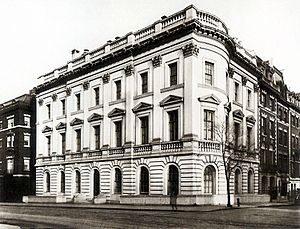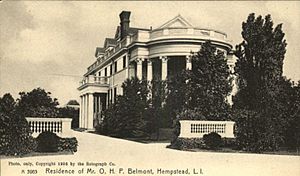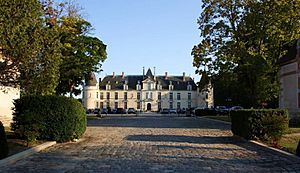Alva Belmont facts for kids
Quick facts for kids
Alva Belmont
|
|
|---|---|
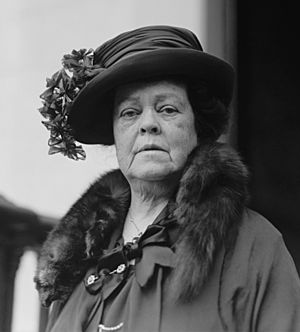
Alva Belmont in 1922
|
|
| Born |
Alva Erskine Smith
January 17, 1853 Mobile, Alabama, U.S.
|
| Died | January 26, 1933 (aged 80) Paris, France
|
| Resting place | Woodlawn Cemetery, Bronx, New York |
| Nationality | American |
| Spouse(s) | |
| Children |
|
| Relatives | Robert Desha (grandfather) |
Alva Erskine Belmont (born Smith; January 17, 1853 – January 26, 1933) was an important American woman. She was known for her wealth and for being a major leader in the women's suffrage movement. This movement worked to get women the right to vote.
Alva was a strong person with many ideas. She was not afraid to challenge old traditions. In 1909, she started the Political Equality League. This group helped politicians in New York who supported women's right to vote. She also wrote articles for newspapers.
Later, she joined the National American Woman Suffrage Association (NAWSA). She then created her own Political Equality League. This group worked to get support for women's suffrage across New York City. She led a part of New York City's 1912 Women's Votes Parade. In 1916, she helped start the National Woman's Party. She also organized the first ever protest in front of the White House in January 1917. She became the president of the National Woman's Party and stayed in that role until she died.
Alva was married twice. First, she married William Kissam Vanderbilt. They had three children together. Later, she married Oliver Belmont. Both men were very rich and from important New York City families. Alva was famous for building many grand homes. These included the Petit Chateau in New York and the Marble House in Newport, Rhode Island.
On April 12, 2016, Alva Belmont was honored. President Barack Obama created the Belmont–Paul Women's Equality National Monument in Washington, D.C., named partly after her.
Alva's Early Life
Alva Erskine Smith was born on January 17, 1853. Her birthplace was in Mobile, Alabama. Her father, Murray Forbes Smith, was a merchant. Her mother was Phoebe Ann Desha. Alva had five siblings, but only two sisters, Armide and Mary, lived to be adults.
As a child, Alva spent summers in Newport, Rhode Island. She also traveled to Europe with her parents. In 1859, her family moved to New York City. Later, her mother moved to Paris, France, where Alva went to a private school. After the American Civil War, the family returned to New York. Her mother passed away in 1871.
Alva's Personal Life
Alva met William Kissam Vanderbilt through her best friend, Consuelo Yznaga. William was the grandson of the famous Cornelius Vanderbilt. Alva and William married on April 20, 1875, in New York City.
They had three children:
- Consuelo Vanderbilt (born 1877)
- William Kissam Vanderbilt II (born 1878)
- Harold Stirling Vanderbilt (born 1884)
Alva wanted her daughter, Consuelo, to marry into a noble family. Consuelo married Charles Spencer-Churchill, 9th Duke of Marlborough, in 1895. Years later, in 1921, their marriage was ended. Alva supported this decision. Consuelo later married Jacques Balsan, a French aviation pioneer.
Becoming Part of High Society
Grand Parties and Homes
Alva wanted the Vanderbilt family to be accepted by the most important people in New York society. In March 1883, she held a huge costume ball at her new home on Fifth Avenue. This party had 1000 guests and cost a lot of money. It was one of the most expensive parties ever seen in New York.
A famous story says that Alva did not invite Carrie Astor, the daughter of society queen Caroline Astor, to her ball at first. This made Mrs. Astor visit Alva to get an invitation for her daughter. This visit showed that the Vanderbilts were finally accepted into the highest levels of society. Mrs. Astor said, "The time has come for the Vanderbilts."
Alva dressed as a Venetian noble for the ball. Her sister-in-law, Alice, wore a unique "Electric Light dress" that was covered in diamonds. The ball set a new standard for lavish parties in New York.
Yachts and Opera
Alva also helped create the Metropolitan Opera in 1883. She and other wealthy families were not allowed to have opera boxes at the old Academy of Music. So, they started their own opera house, which is still famous today.
In 1886, Alva's husband inherited a lot of money. Alva then wanted the biggest yacht in the world. William had the Alva built, which was 285 feet long. It was the largest private yacht at the time. The Vanderbilts used it to travel in style.
Alva then wanted a grand summer home in Newport, Rhode Island. William built the Marble House for her. It was next to Mrs. Astor's home. These very grand displays of wealth showed how rich and powerful some Americans had become.
Alva's Second Marriage
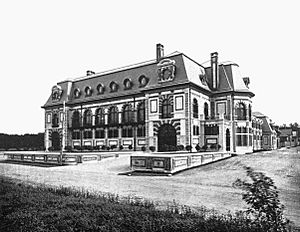
In 1895, Alva Vanderbilt surprised everyone by divorcing her husband. Divorce was very rare among rich families then. She received a large amount of money and several estates. She already owned Marble House.
On January 11, 1896, Alva married Oliver Belmont. He was a friend of her ex-husband and also very wealthy. Oliver died suddenly in 1908. After his death, Alva became very involved in the women's suffrage movement.
Fighting for Women's Right to Vote
Alva Belmont gave a lot of money to the suffrage movement in both the United Kingdom and the United States. In 1909, she started the Political Equality League. She wrote articles and supported workers during a strike. She even paid bail for women who were arrested during protests.
She joined the National American Woman Suffrage Association (NAWSA) in 1909. She saw how dedicated Emmeline Pankhurst and her followers were in London. This inspired Alva to commit even more to the cause. When she returned to the U.S., she paid for new offices for NAWSA in New York. She also started her own Political Equality League to gain support in different neighborhoods. She led a part of New York City's 1912 Women's Votes Parade.
Alva tried to include all women in the movement. She worked with African American clubwomen to form a Black branch of her Political Equality League. She opened a "suffrage settlement house" in Harlem. She also invited African American women and immigrants to retreats at her home, Beacon Towers. However, some parts of the movement still struggled with including everyone.
In 1913, the Congressional Union for Woman Suffrage (CU) separated from NAWSA. Alva joined the CU. She was determined to pass the 19th Amendment, which would give women the right to vote. In 1914, she held a "Conference of Great Women" at her Marble House. Her daughter, Consuelo, who also supported suffrage, spoke at the meeting.
In 1916, Alva and Alice Paul started the National Woman's Party. They organized the first ever protest in front of the White House in January 1917. Alva was chosen as president of the National Woman's Party and held this position until her death. She bought a building in Washington, D.C., for the group's headquarters in 1929. This building is now the Belmont–Paul Women's Equality National Monument.
Later Life and Death
From the early 1920s, Alva lived mostly in France. She wanted to be close to her daughter, Consuelo. She bought and restored a 16th-century castle called Château d'Augerville. In 1932, she had a stroke that left her partly paralyzed. She died in Paris on January 26, 1933, from heart and lung problems.
Her funeral was held at Saint Thomas Episcopal Church in New York City. All of her pallbearers were women, and many suffragists attended. She is buried with Oliver Belmont in the Belmont Mausoleum at Woodlawn Cemetery in The Bronx, New York.
Alva's Building Projects
Alva Belmont loved building and designing homes. She owned many mansions during her life, sometimes as many as nine at once. She often worked with architect Richard Morris Hunt. She was one of the first women to be a member of the American Institute of Architects. After Hunt died, she worked with his sons' firm, Hunt & Hunt.
The Petit Chateau
As a young wife, Alva Vanderbilt worked with Richard Morris Hunt from 1878 to 1882. They designed a French Renaissance-style castle called the Petit Chateau. This was for her family at 660 Fifth Avenue in Manhattan. She held a very expensive costume ball to open this grand home. It was torn down in 1929.
Marble House
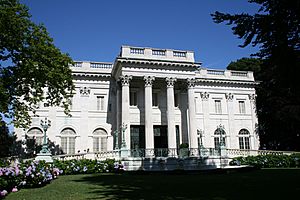
In 1878, Hunt also started work on their country home on Long Island, called Idle Hour. This house was added to until 1889 and later burned down in 1899. A new, fireproof mansion was built on the estate.
Hunt was hired again to design the Marble House in Newport, Rhode Island. This was a 39th birthday gift for William K. Vanderbilt and a summer "cottage" for Alva. Built from 1888 to 1892, this house was a major social landmark. It helped change Newport from a quiet summer town to a place of very grand stone palaces. It was said to cost $11 million and had 36 servants.
Belcourt
After her divorce from Vanderbilt and marriage to Oliver Belmont, Alva began to change Belmont's large Newport mansion, Belcourt. She made many changes to the inside of the house. She mixed French and English Gothic and Renaissance styles.
477 Madison Avenue
In 1899, Alva and Oliver bought land in Manhattan to build a new home. This mansion became known as the Mrs. O. H. P. Belmont House. It was a three-story townhouse with a stone front. When Oliver Belmont died, Alva added a special room to the house. This room was a copy of a Gothic room in Belcourt. It was called The Armory and was the largest room in the house. She and her youngest son, Harold, moved into the house in 1909. The Armory was later used as a place for women suffragists to give talks. She sold the house in 1923.
Brookholt
Before their new Manhattan home, the Belmonts built another mansion called Brookholt in 1897. It was in East Meadow, New York on Long Island. Oliver Belmont died there in 1908. For a short time, Alva used the estate as a training school for women farmers. She sold Brookholt in 1915, and the house was later destroyed by fire.
Family Mausoleum
After Oliver Belmont's death, Alva asked for a family mausoleum to be built. This was in Woodlawn Cemetery. It was a copy of a chapel in France. It took several years to build and was finished in 1913.
Beacon Towers
Alva's last new mansion in the United States was Beacon Towers. It was built on Long Island's North Shore from 1917–18. It looked like a Gothic castle. In 1925, Alva closed the castle. It was sold to William Randolph Hearst in 1927 and torn down in 1945. Some people think it helped inspire the home of Jay Gatsby in F. Scott Fitzgerald's The Great Gatsby.
Château d'Augerville
Alva moved to France in 1923. She had a townhouse in Paris and a villa on the French Riviera. In 1926, she bought and restored the 15th-century Château d'Augerville. This became her main home.
Alva did a lot of work to restore and change the castle. She made the river flowing through the estate wider. She also brought paving stones from Versailles for the courtyard. She added a large new gate and moved the kitchens. She even added a bowling alley! After she died in 1933, the castle went to her daughter, Consuelo. Consuelo sold it in 1937.
Images for kids
See also
 In Spanish: Alva Belmont para niños
In Spanish: Alva Belmont para niños


